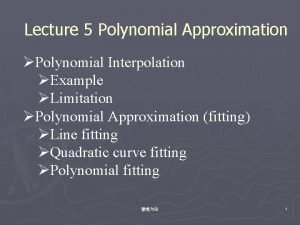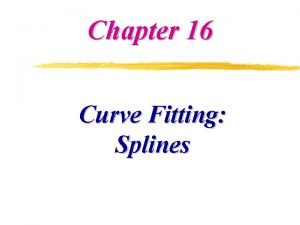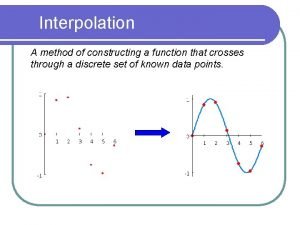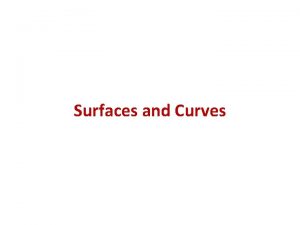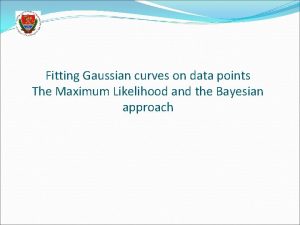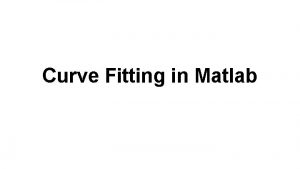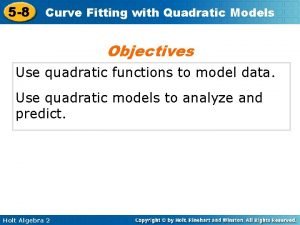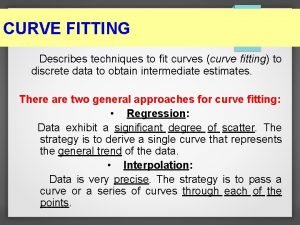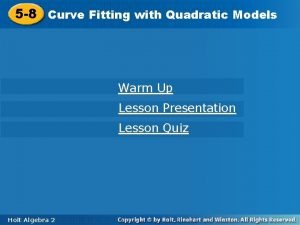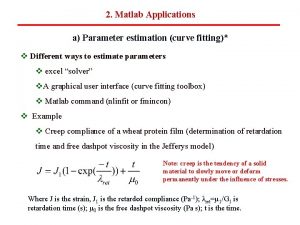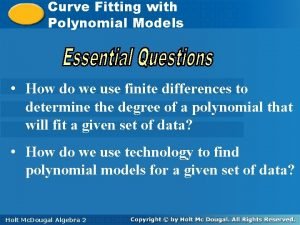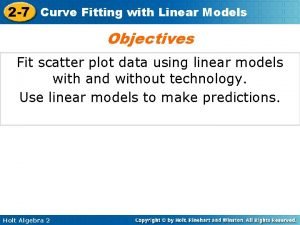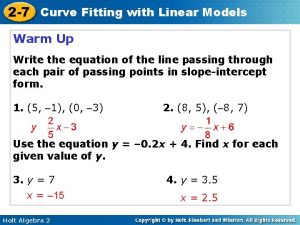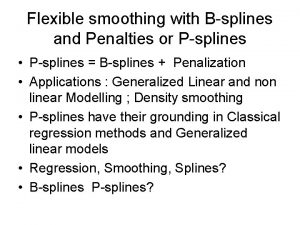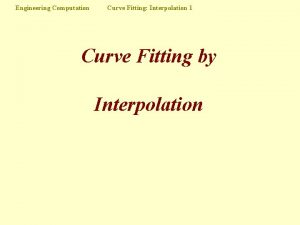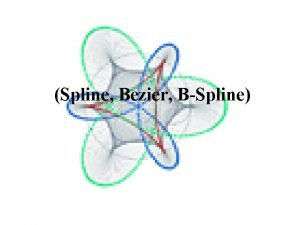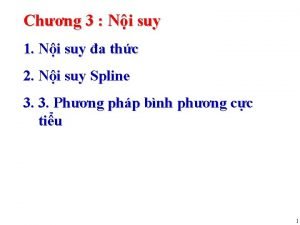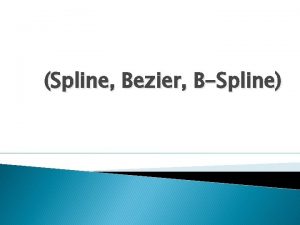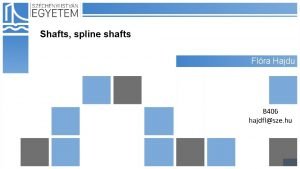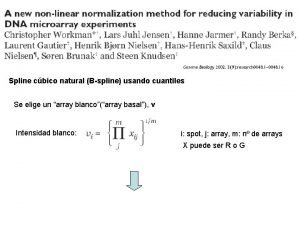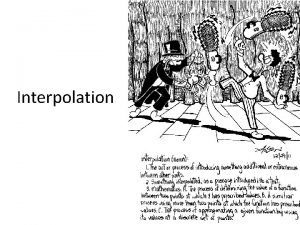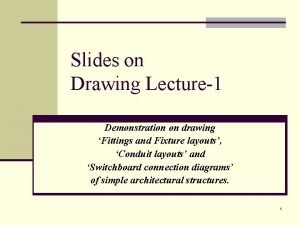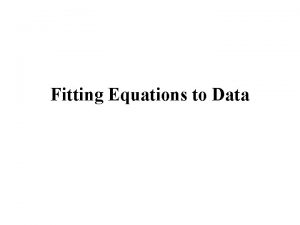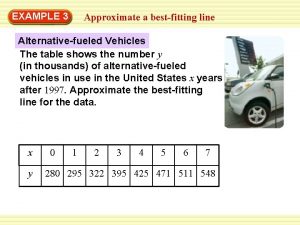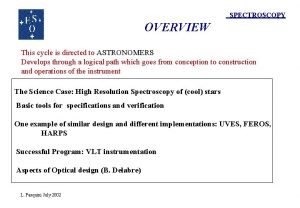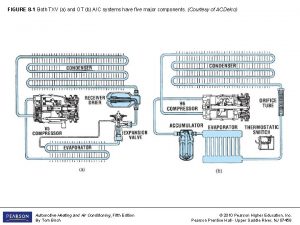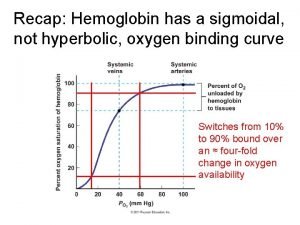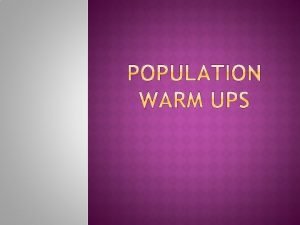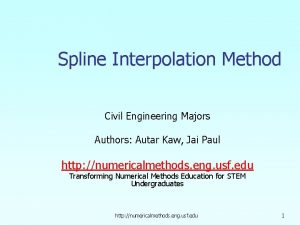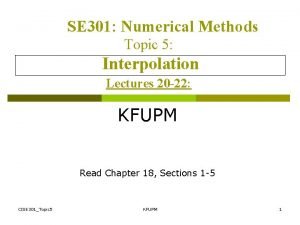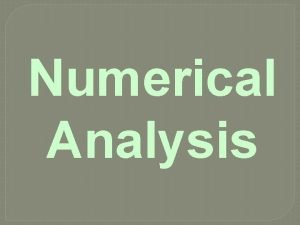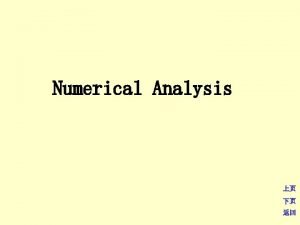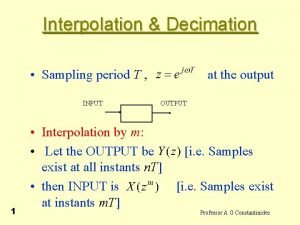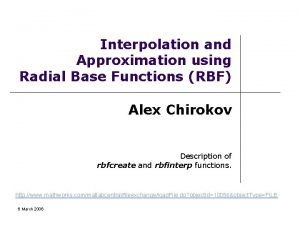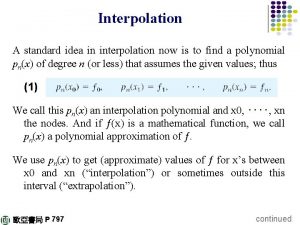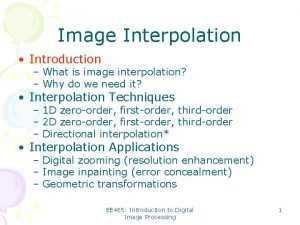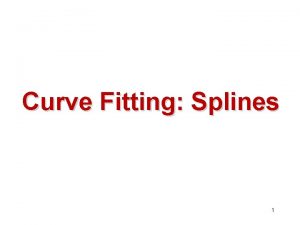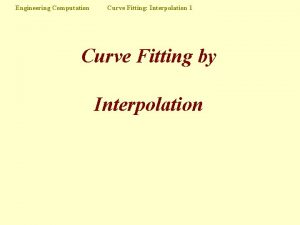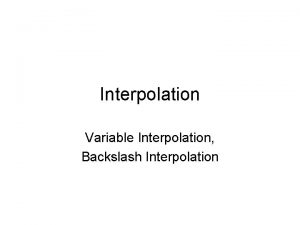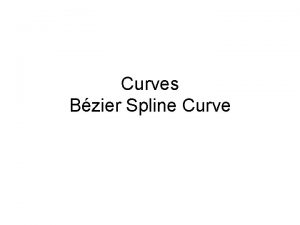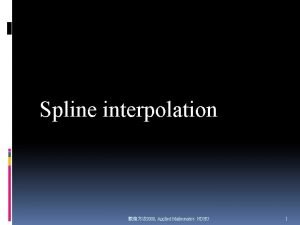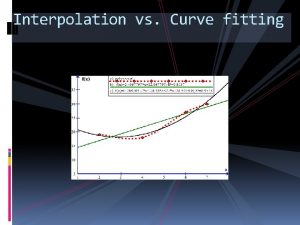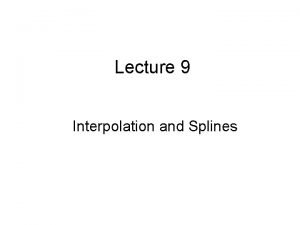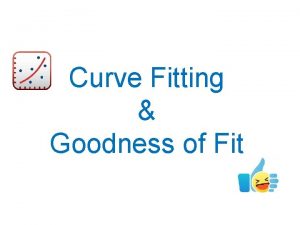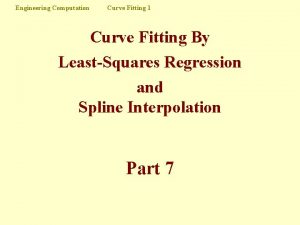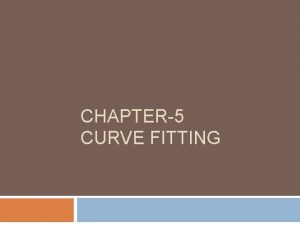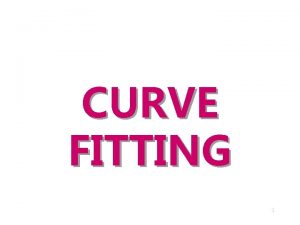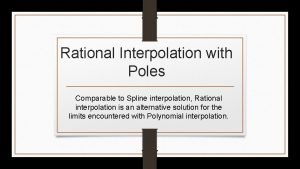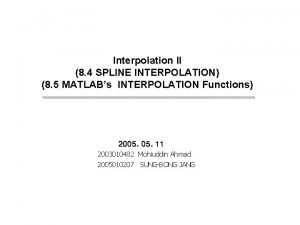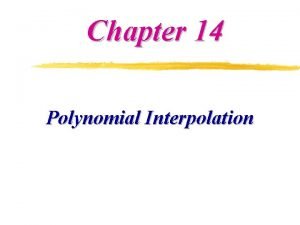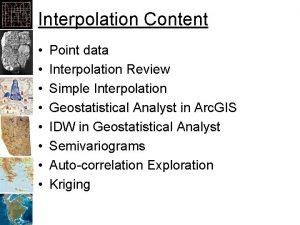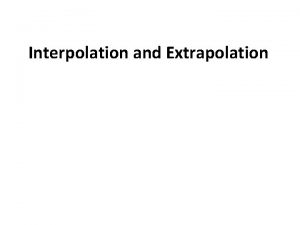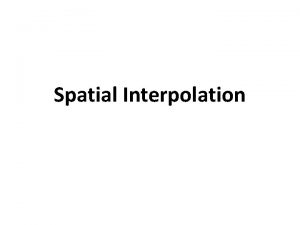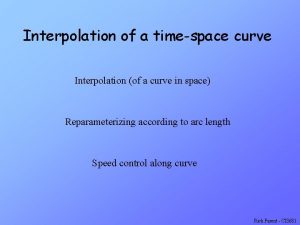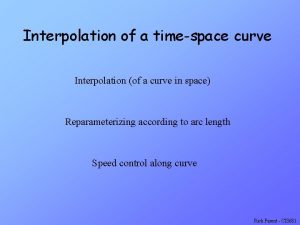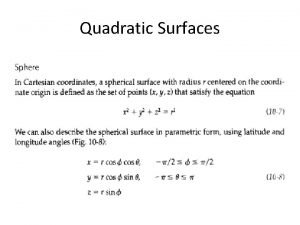Chapter 16 Curve Fitting Splines Spline Interpolation z

























![Quadratic Spline Interpolation function [A, b] = quadratic(x, f) % exact solution f(x)=x^3 -5 Quadratic Spline Interpolation function [A, b] = quadratic(x, f) % exact solution f(x)=x^3 -5](https://slidetodoc.com/presentation_image_h/be8db22593182d94256a814dfc9a6bbf/image-26.jpg)
![Quadratic Spline Interpolation >> x=[-1 0 2 5 6]; f=[-5 4 -2 19 58]; Quadratic Spline Interpolation >> x=[-1 0 2 5 6]; f=[-5 4 -2 19 58];](https://slidetodoc.com/presentation_image_h/be8db22593182d94256a814dfc9a6bbf/image-27.jpg)















![>> xx=[-1 0 2 5 6]; f = [-5 4 -2 19 58]; >> >> xx=[-1 0 2 5 6]; f = [-5 4 -2 19 58]; >>](https://slidetodoc.com/presentation_image_h/be8db22593182d94256a814dfc9a6bbf/image-43.jpg)






![Spline Interpolations >> x=[1 2 4 7 9 10] x = 1 2 4 Spline Interpolations >> x=[1 2 4 7 9 10] x = 1 2 4](https://slidetodoc.com/presentation_image_h/be8db22593182d94256a814dfc9a6bbf/image-50.jpg)


![MATLAB Function: interp 2 >> >> >> [x, y, z]=peaks(100); [xi, yi]=meshgrid(-3: 0. 1: MATLAB Function: interp 2 >> >> >> [x, y, z]=peaks(100); [xi, yi]=meshgrid(-3: 0. 1:](https://slidetodoc.com/presentation_image_h/be8db22593182d94256a814dfc9a6bbf/image-53.jpg)

- Slides: 54

Chapter 16 Curve Fitting: Splines

Spline Interpolation z. There are cases where polynomial interpolation is bad z. Noisy data z. Sharp Corners (slope discontinuity) z. Humped or Flat data Ø Overshoot Ø Oscillations

Example: f(x) = sqrt(abs(x)) Interpolation at 4, 3, 2, 1, 0, 1, 2, 3, 4

Spline Interpolation Cubic interpolation 5 th-order 7 th-order Linear spline

Spline Interpolation Idea behind splines • Use lower order polynomials to connect subsets of data points • Make connections between adjacent splines smooth • Lower order polynomials avoid oscillations and overshoots

Spline Interpolation z Use “piecewise” polynomials instead of a single polynomial z Spline -- a thin, flexible metal or wooden lath z Bent the lath around pegs at the required points z Spline curves -- curves of minimum strain energy z Piecewise Linear Interpolation z Piecewise Quadratic Interpolation z Piecewise Cubic Interpolation (cubic splines)

Drafting Spline z Continuous function and derivatives Zero curvatures at end points

Splines Ø There are n-1 intervals and n data points Ø si(x) is a piecewise low-order polynomial

Spline fits of a set of 4 points


Example: Ship Lines waterline

Bow Stern

Original database Spline interpolation for submerged hull (below waterline)

Linear Splines z Connect each two points with straight line functions connecting each pair of points b is the slope between points

Linear Splines si (x) = ai + bi (x xi) x 1 x 2 x 3 x 4

Linear Splines Identical to Lagrange interpolating polynomials

Linear splines Ø Connect each two points with straight line Ø Functions connecting each pair of points are Ø slope

Linear splines are exactly the same as linear interpolation! Example:

Linear Splines z. Problem with linear splines -- not smooth at data points (or knots) z. First derivative (slope) is not continuous z. Use higher-order splines to get continuous derivatives z. Equate derivatives at neighboring splines z. Continuous functional values and derivatives

Quadratic Splines Quadratic splines - continuous first derivatives May have discontinuous second and higher derivatives Derive second order polynomial between each pair of points For n points (i=1, …, n): (n-1) intervals & 3(n-1) unknown parameters (a’s, b’s, and c’s) Need 3(n-1) equations

Quadratic Splines x) ( s 1 f(x 2) s 2 (x) f(x 3) s 3 (x) f(x 4) s 4 (x) f(x 5) f(x 1) Interval 1 x 2 Interval 3 x 3 si(x) = ai + bi (x xi) + ci(x xi)2 Interval 4 x 5 3(n-1) unknowns

Piecewise Quadratic Splines Example with n = 5 1. The functional must pass through all the points xi (continuity condition) 2. The function values of adjacent polynomials must be equal at all nodes (identical to condition 1. ) 2(n-2) + 2 = 2(n-1) 3. The 1 st derivatives are continuous at interior nodes xi, (n-2) 4. Assume that the second derivatives is zero at the first points 2(n 1) + (n 2) + (1) = 3(n 1) equations for 3(n 1) unknowns

Piecewise Quadratic Splines z Function must pass through all the points x = xi (2 n 2 eqns) z This also ensure the same function values of adjacent polynomials at the interior knots (hi = xi+1 – xi) z Apply to every interval (4 intervals, 8 equations)

Piecewise Quadratic Splines z Continuous slope at interior knots x = xi (n 2 equations) z Apply to interior knots x 2 , x 3 and x 4 (3 equations) z Zero curvatures at x = x 1 (1 equation)

Example: Quadratic Spline
![Quadratic Spline Interpolation function A b quadraticx f exact solution fxx3 5 Quadratic Spline Interpolation function [A, b] = quadratic(x, f) % exact solution f(x)=x^3 -5](https://slidetodoc.com/presentation_image_h/be8db22593182d94256a814dfc9a6bbf/image-26.jpg)
Quadratic Spline Interpolation function [A, b] = quadratic(x, f) % exact solution f(x)=x^3 -5 x^2+3 x+4 % x=[-1 0 2 5 6]; f=[-5 4 -2 19 58]; h 1=x(2)-x(1); h 2=x(3)-x(2); h 3=x(4)-x(3); h 4=x(5)-x(4); f 1=f(1); f 2=f(2); f 3=f(3); f 4=f(4); f 5=f(5); A=[1 0 0 0 h 1^2 0 0 0 1 0 0 0 h 2^2 0 0 0 1 0 0 0 h 3^2 0 0 0 1 0 0 0 h 4^2 0 1 2*h 1 0 -1 0 0 0 1 2*h 2 0 -1 0 0 0 1 2*h 3 0 -1 0 0 0 0]; b=[f 1; f 2 -f 1; f 2; f 3 -f 2; f 3; f 4 -f 3; f 4; f 5 -f 4; 0; 0];
![Quadratic Spline Interpolation x1 0 2 5 6 f5 4 2 19 58 Quadratic Spline Interpolation >> x=[-1 0 2 5 6]; f=[-5 4 -2 19 58];](https://slidetodoc.com/presentation_image_h/be8db22593182d94256a814dfc9a6bbf/image-27.jpg)
Quadratic Spline Interpolation >> x=[-1 0 2 5 6]; f=[-5 4 -2 19 58]; >> [A, b]=quadratic(x, f) p = Ab -5. 0000 9. 0000 0 4. 0000 9. 0000 -6. 0000 -2. 0000 -15. 0000 7. 3333 19. 0000 29. 0000 10. 0000 dx = 0. 1; z 1=x(1): dx: x(2); s 1=p(1)+p(2)*(z 1 -x(1))+p(3)*(z 1 -x(1)). ^2; z 2=x(2): dx: x(3); s 2=p(4)+p(5)*(z 2 -x(2))+p(6)*(z 2 -x(2)). ^2; z 3=x(3): dx: x(4); s 3=p(7)+p(8)*(z 3 -x(3))+p(9)*(z 3 -x(3)). ^2; z 4=x(4): dx: x(5); s 4=p(10)+p(11)*(z 4 -x(4))+p(12)*(z 4 -x(4)). ^2; H=plot(z 1, s 1, 'r', z 2, s 2, 'b', z 3, s 3, 'm', z 4, s 4, 'g'); xx=-1: 0. 1: 6; fexact=xx. ^3 -5*xx. ^2+3*xx+4; hold on; G=plot(xx, fexact, 'c', x, f, 'ro'); set(H, 'Line. Width', 3); set(G, 'Line. Width', 3, 'Marker. Size', 8); H 1=xlabel('x'); set(H 1, 'Font. Size', 15); H 2=ylabel('f(x)'); set(H 2, 'Font. Size', 15); H 3=title('f(x)=x^3 -5 x^2+3 x+4'); set(H 3, 'Font. Size', 15);

Quadratic Spline s 2(x) s 1(x) s 4(x) Exact function s 3(x)

Cubic Splines Cubic splines avoid the straight line and the over-swing Can develop method like we did for quadratic – 4(n– 1) unknowns – 4(n– 1) equations Ø interior knot equality Ø end point fixed Ø interior knot first derivative equality Ø assume derivative value if needed

Piecewise Cubic Splines s n-1 (x) Continuous slopes and curvatures s 1 (x ) s 2 (x) x 1 x 2 x 3 xn-1 xn 4(n 1) unknowns

Piecewise Cubic Splines x 0 ) ” x) s 3 ( ” (x s 1 ) x ”( s 2”(x) x 1 x 2 S nxn-1 1 xn si (x) - piecewise cubic polynomials si’(x) - piecewise quadratic polynomials (slope) si”(x) - piecewise linear polynomials (curvatures) Reduce to (n-1) unknowns and (n-1) equations for si’’

Cubic Splines z Piecewise cubic polynomial with continuous derivatives up to order 2 1. The function must pass through all the data points gives 2(n-1) equations i = 1, 2, …, n-1

Cubic Splines 2. First derivatives at the interior nodes must be equal: (n-2) equations 3. Second derivatives at the interior nodes must be equal: (n-2) equations

Cubic Splines 4. Two additional conditions are needed (arbitrary) The last two equations Total equations: 2(n-1) + (n-2) +2 = 4(n-1)

Cubic Splines Ø Solve for (ai, bi, ci, di) – see textbook for details Ø Tridiagonal system with boundary conditions c 1 = cn= 0

Cubic Splines Tridiagonal matrix

Hand Calculations

Hand Calculations Ø can be further simplified since c 1 = c 4 = 0 (natural spline)

Cubic Spline Interpolation

Cubic Splines Ø Piecewise cubic splines (cubic polynomials)

Cubic Spline Interpolation z The exact solution is a cubic function z Why cubic spline interpolation does not give the exact solution for a cubic polynomial? z Because the conditions on the end knots are different! z In general, f (x 0) 0 and f (xn) 0 !!

Cubic Spline Interpolation
![xx1 0 2 5 6 f 5 4 2 19 58 >> xx=[-1 0 2 5 6]; f = [-5 4 -2 19 58]; >>](https://slidetodoc.com/presentation_image_h/be8db22593182d94256a814dfc9a6bbf/image-43.jpg)
>> xx=[-1 0 2 5 6]; f = [-5 4 -2 19 58]; >> Cubic_spline(xx, f); Resulting piecewise function: (i = 1) s 1 = (-5. 000000)+(11. 081218)*(x-(-1. 000000)) s 2 = (0. 000000)*(x-(-1. 000000)). ^2+(-2. 081218)*(x-(-1. 000000)). ^3 Resulting piecewise function: s 1 = (i = 2) (4. 000000)+(4. 837563)*(x-(0. 000000)) s 2 = (-6. 243655)*(x-(0. 000000)). ^2+(1. 162437)*(x-(0. 000000)). ^3 Resulting piecewise function: s 1 = (i = 3) (-2. 000000)+(-6. 187817)*(x-(2. 000000)) s 2 = (0. 730964)*(x-(2. 000000)). ^2+(1. 221658)*(x-(2. 000000)). ^3 Resulting piecewise function: s 1 = (i = 4) (19. 000000)+(31. 182741)*(x-(5. 000000)) s 2 = (11. 725888)*(x-(5. 000000)). ^2+(-3. 908629)*(x-(5. 000000)). ^3

Cubic Spline Interpolation Piecewise cubic Continuous slope Continuous curvature zero curvatures at end knots exact solution

End Conditions of Splines Ø Natural spline : zero second derivative (curvature) at end points Ø Clamped spline: prescribed first derivative (clamped) at end points Ø Not-a-Knot spline: continuous third derivative at x 2 and xn-1

>> >> x = linspace(-1, 1, 9); y = 1. /(1+25*x. ^2); xx = linspace(-1, 1, 100); yy = spline(x, y, xx); yr=1. /(1+25*xx. ^2); H=plot(x, y, 'o', xx, yy, xx, yr, '--'); Continuous third derivatives at x 2 and xn-1 Ø Comparison of Runge’s function (dashed red line) with a 9 -point not -a-knot spline fit generated with MATLAB (solid green line)

Clamped End Spline - Use 11 values including slopes at end points >> yc = [1 y – 4]; % 1 and -4 are the 1 st-order derivatives (or slopes)at 1 st & last point, respectively. >> yyc = spline(x, yc, xx); >> >> H=plot(x, y, 'o', xx, yyc, xx, yr, '--'); Ø Note that first derivatives of 1 and 4 are specified at the left and right boundaries, respectively.

MATLAB Functions z One-dimensional interpolations z yy = spline (x, y, xx) z yi = interp 1 (x, y, xi, ‘method’) z yi = interp 1 (x, y, xi, ‘linear’) z yi = interp 1 (x, y, xi, ‘spline’) – not-a-knot spline z yi = interp 1 (x, y, , xi, ‘pchip’) – cubic Hermite z yi = interp 1 (x, y, , xi, ‘cubic’) – cubic Hermite z yi = interp 1 (x, y, , xi, ‘nearest’) – nearest neighbor

MATLAB Function: interp 1 Ø Piecewise polynomial interpolation on velocity time series for an automobile
![Spline Interpolations x1 2 4 7 9 10 x 1 2 4 Spline Interpolations >> x=[1 2 4 7 9 10] x = 1 2 4](https://slidetodoc.com/presentation_image_h/be8db22593182d94256a814dfc9a6bbf/image-50.jpg)
Spline Interpolations >> x=[1 2 4 7 9 10] x = 1 2 4 7 9 10 4 9 2 >> y=[3 -2 5 4 9 2] y = 3 -2 5 >> xi=1: 0. 1: 10; >> y 1=interp 1(x, y, xi, 'linear'); >> y 2=interp 1(x, y, xi, 'spline'); >> y 3=interp 1(x, y, xi, 'cubic'); >> plot(x, y, 'ro', xi, y 1, xi, y 2, xi, y 3, 'Line. Width', 2, 'Marker. Size', 12) >> print -djpeg spline 00. jpg

Spline Interpolations Linear Not-a-knot Cubic

MATLAB’s Functions z. Two-dimensional interpolations zzi = interp 2 (x, y, z, xi, yi)
![MATLAB Function interp 2 x y zpeaks100 xi yimeshgrid3 0 1 MATLAB Function: interp 2 >> >> >> [x, y, z]=peaks(100); [xi, yi]=meshgrid(-3: 0. 1:](https://slidetodoc.com/presentation_image_h/be8db22593182d94256a814dfc9a6bbf/image-53.jpg)
MATLAB Function: interp 2 >> >> >> [x, y, z]=peaks(100); [xi, yi]=meshgrid(-3: 0. 1: 3, -3: 0. 1: 3); zi = interp 2(x, y, z, xi, yi); surf(xi, yi, zi) print -djpeg 075 peaks 1. jpg [x, y, z]=peaks(10); [xi, yi]=meshgrid(-3: 0. 1: 3, -3: 0. 1: 3); zi = interp 2(x, y, z, xi, yi); surf(xi, yi, zi) print -djpeg 075 peaks 2. jpg 100 data base 10 data base

CVEN 302 -501 Homework No. 11 z Chapter 16 z Problem 16. 1(a) (30) – Hand Calculation z Problem 16. 1(b) (20)– MATLAB program not-a-knot spline: yy = spline(x, y, xx) z Problem 16. 1(c)(20) – MATLAB program z Chapter 19 z Problem 19. 2 (20)– Hand Calculation z Problem 19. 4 (20)– Hand Calculation z Due on Wed. 11/05/08 at the beginning of the period
 Spline interpolation vs polynomial interpolation
Spline interpolation vs polynomial interpolation Taper key design
Taper key design Spline fit matlab
Spline fit matlab Spline interpolation
Spline interpolation 주식 평균단가 엑셀
주식 평균단가 엑셀 B spline curve definition
B spline curve definition Gaussian curve fitting
Gaussian curve fitting Curve fitting matlab
Curve fitting matlab Quadratic curve fitting
Quadratic curve fitting Exponential and logarithmic models
Exponential and logarithmic models Curve fitting techniques
Curve fitting techniques Curve fitting with quadratic models
Curve fitting with quadratic models Parameter estimation in matlab
Parameter estimation in matlab Curve fitting with polynomial models
Curve fitting with polynomial models Curve fitting with linear models
Curve fitting with linear models Labview curve fitting
Labview curve fitting Curve fitting with linear models
Curve fitting with linear models Flexible smoothing with b-splines and penalties
Flexible smoothing with b-splines and penalties Curve interpolation formula
Curve interpolation formula U4ilui-din8 -site:youtube.com
U4ilui-din8 -site:youtube.com Spline bậc 3
Spline bậc 3 Spline terminology
Spline terminology Shaft undercut standards
Shaft undercut standards Spline natural
Spline natural Inverse distance weighted interpolation formula
Inverse distance weighted interpolation formula B-spline example
B-spline example Thin plate spline
Thin plate spline Conduit layout diagram
Conduit layout diagram Wwglass
Wwglass Fitting equations to data
Fitting equations to data Fitting into society
Fitting into society Matlab
Matlab Castan golf
Castan golf Approximate the best fitting line for the data
Approximate the best fitting line for the data Dr comfort return form
Dr comfort return form Butler system heat exchanger
Butler system heat exchanger Transformer fitting
Transformer fitting Main sequence fitting
Main sequence fitting A/c fitting size chart
A/c fitting size chart Steer clipping and fitting techniques
Steer clipping and fitting techniques Hyperbolic binding curve
Hyperbolic binding curve S curve and j curve
S curve and j curve Unilateral occlusal balance
Unilateral occlusal balance J curve vs s curve
J curve vs s curve Civil interpolation
Civil interpolation Interpolation method example
Interpolation method example Definition of numerical methods
Definition of numerical methods Cubic hermite interpolation
Cubic hermite interpolation Extrapolation vs interpolation
Extrapolation vs interpolation Interpolation and decimation
Interpolation and decimation Radial basis function interpolation matlab
Radial basis function interpolation matlab Newtons backward interpolation
Newtons backward interpolation Interpolasi data
Interpolasi data Interpolation formula for irr
Interpolation formula for irr Interpolation method example
Interpolation method example
